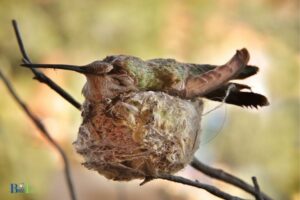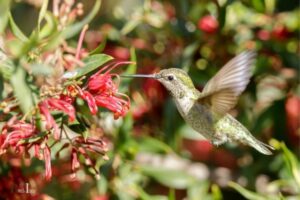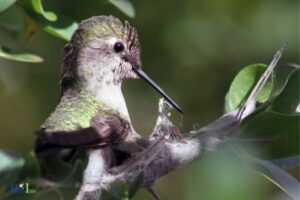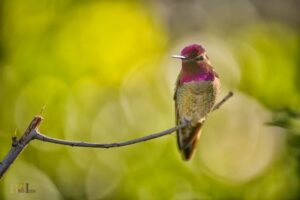How to Keep Hummingbird Nectar from Freezing: Steps!
To keep hummingbird nectar from freezing, use a heated hummingbird feeder, insulation materials, placing the feeder in a sheltered location, and regularly rotating feeders during cold weather.
Hummingbird nectar can freeze during cold weather, which can cause difficulties for hummingbirds trying to feed and access the necessary nutrients.
It’s crucial to take measures to prevent nectar from freezing to ensure hummingbirds can continue to thrive in colder climates.
By incorporating heating elements, insulation, strategic placement, and rotating feeders, you can protect the nectar and help support hummingbirds during winter months.
Placing the feeder in a sheltered location away from wind and cold exposure can also help prevent freezing.
Finally, rotating feeders by bringing them indoors at night and putting them back outside during the daytime can ensure the nectar remains thawed and available for hummingbirds throughout the day.
6 Methods to Prevent Hummingbird Nectar from Freezing
| Method | Description | Pros | Cons |
| Insulated Feeder | Use a feeder with insulation to protect the nectar from freezing. | Low maintenance and easy to set up. | May not work in extremely cold areas. |
| Heating Elements | Add a heating device designed for bird feeders to keep the nectar warm. | Effective in very cold temperatures. | Requires electricity or batteries. |
| Positioning | Place the feeder in a warm location; near a window or protected from wind. | Free and low maintenance. | Limited by available locations. |
| Frequent Refilling | Refill the feeder with fresh, warm nectar regularly during freezing weather. | Ensures fresh nectar is available. | Time-consuming and requires attention. |
| Microwaveable Feeder | Use a feeder that can be heated in the microwave to thaw frozen nectar. | Quick and convenient. | Requires periodic microwaving. |
| Bring Indoors at Night | Bring the feeder inside during the night and replace it in the morning. | Prevents freezing overnight. | Requires daily effort. |
Key Takeaway
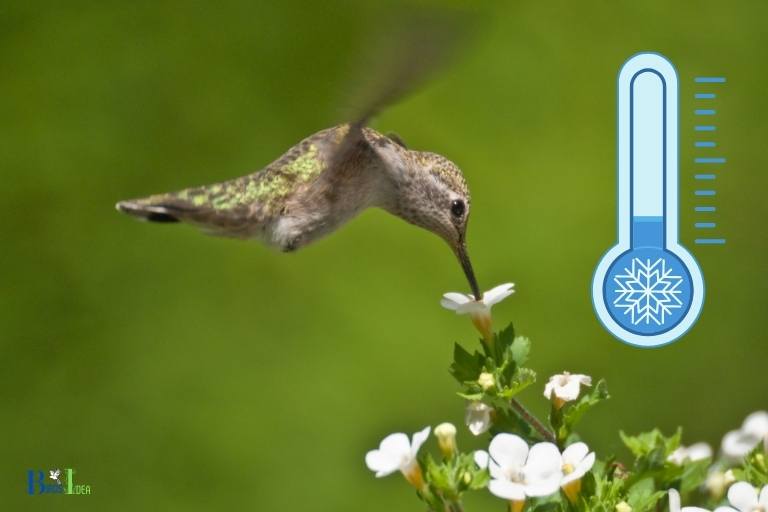
Five Facts About: Keeping Hummingbird Nectar from Freezing
Understanding Hummingbirds’ Feeding Habits
Brief Overview Of Hummingbirds’ Diet
Hummingbirds are known for their high-energy demand and rapid metabolism. These tiny birds need to consume half of their body weight in food every day, primarily consisting of nectar and insects.
Their diet primarily consists of:
- Nectar from flowering plants
- Small insects like gnats, fruit flies, and spiders
- Tree sap
- Pollen and fungi
Importance Of Nectar Temperature
For hummingbirds, nectar temperature plays an undeniable role in their feeding habits. They prefer nectar at room temperature, around 70°f.
Cold nectar can cause several issues for the birds, including:
- Serious calorie loss when they have to expend additional energy to thaw the nectar
- Inefficient digestion that slows down their metabolic rate
- Increased mortality rate, especially during the winter season
How Cold Temperatures May Affect Hummingbirds’ Feeding
Hummingbirds are susceptible to the effects of cold weather on their feeding habits. During winters, the birds migrate to warmer regions. However, they can still encounter cold temperatures, making it difficult for them to find nectar.
As a result, they may switch to dietary supplements rich in fat and protein, such as insects and tree sap.
Role Of Hummingbird Feeders In Feeding
Hummingbird feeders play a crucial role in ensuring that the birds have access to nectar, especially during the frosty months. However, these feeders can sometimes present challenges since the nectar often freezes in low temperatures.
To mitigate this problem, you can try the following tips:
- Use feeders with an internal heating system or wrap them with insulating materials.
- Increase the sugar concentration in the nectar (a 4: 1 ratio) so that it freezes at a lower temperature.
- Change the nectar regularly, at least every three days to prevent spoilage or fermentation.
- Place the feeder in an area out of the sun and wind, but still accessible to the birds.
By understanding hummingbirds’ diet, the importance of nectar temperature, the effects of cold temperatures on their feeding habits, and the role of hummingbird feeders in feeding, you can take proactive steps to provide a warm and accessible food source for these amazing birds.
Common Ways To Keep Hummingbird Nectar From Freezing
Birdwatching enthusiasts who live in colder climates know that hummingbirds require nectar to survive. During winter, however, temperatures may drop and freeze nectar, leaving the birds without a food source.
Fortunately, there are several ways to prevent hummingbird nectar from freezing.
Let’s look at the traditional methods and hacks.
Traditional Methods And Hacks
- Bring the feeder indoors at night. Bring the feeder in every night once the temperature hits freezing. By taking the hummingbird feeder indoors, you can keep the nectar from freezing. Alternatively, you can move the feeder to a warmer location, such as an enclosed porch or a garage.
- Use a light bulb to generate heat. Use an outdoor-rated light bulb under or near the feeder to keep the nectar from freezing. The bulb should provide enough warmth to keep the air temperature around the feeder above freezing.
- Wrap the feeder with insulation. Use an insulation blanket or wrap to keep the feeder warm. You can fashion your own using simple materials like bubble wrap or old foam mats.
- Add sugar to the nectar. Add more sugar to the nectar mixture, but be careful not to make it too thick. The sugar will help lower the freezing temperature.
- Use a heated feeder. A heated hummingbird feeder is a great investment for birdwatchers who have frequent freezing temperatures. Heated feeders can be plugged in and will keep the nectar from freezing, even during the harshest of winters.
Modern Freezing Prevention Tools
- Heat lamps. Install an outdoor-rated heat lamp to keep the nectar from freezing. If you have a covered porch or patio, this may be an ideal spot to set up the feeder and heat lamp in colder months.
- Heated perches. A heated perch provides warmth for the birds to sit on and rest in between feedings, helping them conserve energy during winter.
- De-icing units. De-icing units can be installed in ponds and water features to keep the water from freezing. These units can help keep the air temperature above freezing, making it easier to keep hummingbird nectar from freezing.
- Insulated feeders. Insulated hummingbird feeders contain a layer of foam insulation that keeps the nectar from freezing without the need for additional heat sources.
- Thermostatically controlled feeders. These feeders have built-in thermostats that turn on when the temperature drops to a certain degree, preventing the nectar from freezing.
There are several traditional methods and modern tools to keep hummingbird nectar from freezing even during the winter months. By using these options, bird watchers can ensure that hummingbirds have access to a food source year-round.
Best Practices For Preventing Nectar From Freezing
Hummingbirds are fascinating creatures to watch, and providing them with nectar is a great way to attract them to our gardens. However, the cold winter months can be challenging for both hummingbirds and bird enthusiasts due to nectar freezing.
In this blog post, we will explore the best practices for preventing nectar from freezing, so you can enjoy watching these delightful birds year-round.
Importance Of Regular Cleaning And Maintenance
Keeping your hummingbird feeders clean and well-maintained is crucial for preventing nectar from freezing.
Here’s why:
- Dirty feeders can harbor harmful bacteria that can make hummingbirds sick.
- If nectar ferments, it can create alcohol, which can be fatal to hummingbirds.
To avoid these issues, clean your feeders regularly using a solution of one-part white vinegar to four parts water. Scrub the feeder with a bottle brush, rinse it with clean water and let it dry before refilling with nectar.
Factors That Cause Nectar To Freeze
Several factors can cause nectar to freeze in cold weather.
Here are some of the main ones:
- Low temperatures: When temperatures drop below freezing, the nectar will freeze.
- Shade: Feeders placed in shaded areas are more likely to freeze because they do not receive heat from the sun.
- Wind: Wind can lower the temperature around a feeder, causing the nectar to freeze faster.
- Metal feeders: Metal conducts heat away from the nectar, so metal feeders are more likely to freeze.
To prevent nectar from freezing, try to place your feeder in a sheltered location, where it will receive some sun and be protected from the wind. You can also consider using plastic or glass feeders instead of metal ones.
Timing And Frequency Of Nectar Refills
During the winter months, hummingbirds need to consume more nectar to stay warm.
To ensure that they have access to an adequate food source, refill your feeder more frequently. When temperatures drop below freezing, consider refilling it daily, so the nectar does not have a chance to freeze.
Tips For Maintaining Optimal Feeding Conditions
Now that you know the main causes of nectar freezing let’s look at some tips to keep your hummingbirds happy and healthy.
- Use a feeder with a built-in heating element to keep the nectar warm in colder temperatures.
- Use a feeder with a large capacity so that you can fill it with enough nectar to last throughout the day.
- Place your feeder in an area that is sheltered from cold winds and receives some sunlight.
- Install weather stripping around the feeder to prevent cold air from getting in.
- Provide a source of water for hummingbirds to drink since they also need water to survive.
By following these best practices, you can help keep nectar from freezing and provide optimal feeding conditions for your hummingbirds. So, sit back, relax, and enjoy the beautiful birds outside your window all year-round.
Diy Methods For Keeping Nectar From Freezing
Hummingbirds are wonderful creatures to attract to your garden. Their lovely chirping sounds and vibrant colors add charm to any outdoor space. However, colder temperatures can bring challenges when it comes to keeping hummingbird nectar from freezing.
Fortunately, there are diy methods to keep nectar from freezing during the winter months.
Here are some innovative solutions to try out:
Making A Homemade Insulation Jacket
One easy and practical solution is creating a homemade insulation jacket for your hummingbird feeder. This will help trap heat and prevent the nectar from freezing.
Here’s what you need to do:
- Cut a piece of insulation foam to fit around the feeder.
- Cut a hole into the foam to fit your feeder.
- Ensure that the foam jacket fits snugly over the feeder, without leaving any air pockets.
Crafting A Cozy Winter Feeder
Another option for keeping hummingbird nectar from freezing is to create a cozy winter feeder. This is a fun diy project that will help you keep your feathered friends happy and healthy all winter long.
Here’s what you need to do:
- Wrap a thick woolen sock around the feeder. Make sure the sock covers the sides and bottom of the feeder.
- Tie the top of the sock in a knot. This will keep the sock in place over the feeder.
- Hang the feeder as you normally would.
Using Diy Heating Equipment
If you prefer more technical solutions, you can also use diy heating equipment to keep hummingbird nectar from freezing.
Here are some options to consider:
- Wrap a string of outdoor christmas lights around the feeder. The heat generated by the lights will keep the nectar from freezing.
- Use a heated bird bath placed beside the feeder. The heat from the bath will help keep the nectar from freezing.
Other Creative Diy Ideas
If you’re looking for other creative ways to keep hummingbird nectar from freezing, here are some ideas to inspire you.
- Place hand warmers around the feeder. This will help keep the nectar from freezing in colder temperatures.
- Use a small battery-powered heater beside the feeder to keep the nectar warm.
- Use a mini greenhouse cover over the feeder to trap heat.
With these diy solutions, you can help provide hummingbirds with a consistent food source throughout the winter months. Try out these methods and enjoy the pleasant chirping sounds of hummingbirds in your garden all year round.
FAQ Of How To Keep Hummingbird Nectar From Freezing
How Can I Stop Hummingbird Nectar From Freezing?
Can I Add Anything To Hummingbird Nectar To Prevent It From Freezing?
What Temperature Does Hummingbird Nectar Freeze At?
Is It Okay To Offer Frozen Nectar To Hummingbirds?
How Often Should I Change The Nectar In My Hummingbird Feeder?
Conclusion
As winter approaches, it is important to ensure that your hummingbird nectar doesn’t freeze. By following the recommended tips, you can keep your feathered friends fed and happy all year round.
Whether it’s using a heated feeder or changing the concentration ratio of sugar and water, there are different methods that can be adopted to prevent the nectar from freezing.
It is essential to monitor the nectar regularly and refill when necessary. Maintaining a consistent supply of nectar throughout the winter months will help keep hummingbirds healthy and satisfied.
So, if you enjoy watching these delightful creatures during the colder months, be sure to implement these simple steps to keep your hummingbird nectar from freezing.
With a little effort, you can enjoy the company of these beautiful birds all year round.


